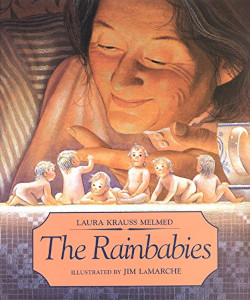The Rainbabies

Author:
Laura Krauss Melmed
Illustrator:
Jim LaMarche
Publication:
1992 by HarperCollins
Genre:
Fairy Tales, Fiction, Picture Books
Pages:
32
Current state:
This book has been evaluated and information added. It has been read and any content considerations have been added.
Book Guide
In the magic of a moonshower, a childless couple find a dozen tiny babies in the grass. Small enough to rock to sleep in a pair of wooden shoes, the children never grow. Even the tiniest babies can bring big adventures, though, and these little ones seem to find trouble as easily as bees find flowers. But the old couple's love never waivers and in the end they are rewarded with their hearts' desire.
Written in classic folktale tradition, illustrated with astonishing paintings, this beautiful story is woven from magic and moonbeams.
From the dust jacket
To view an example page please sign in.
Resource Guide
Episode 70: Why Read Fairy Tales?
Released in 2020 by The Literary Life
Available formats: Streaming Audio
Length: 1 hr. 29 min.
View on the The Literary Life site
"Angelina Stanford and Cindy Rollins tackle the topic of fairy stories, discussing the what, why and how of reading them. Angelina shares the distinctive characteristics of fairy stories in contrast to other types of stories, such as myths. They deal with the question of whether fairy tales are 'escapist', the influence of the Grimm brothers scholarly work on interpreting fairy stories, and allowing the story to unveil its deeper truths without forcing meaning onto it.
Angelina gives an illustration of how to see the gospel messages in fairy tales by talking us through the story of Sleeping Beauty. She refutes the ideas that fairy tales are about human romance or are misogynistic. She also highlights some of the Enlightenment and Puritan responses to fairy tales that still linger with us today. Cindy and Angelina also discuss some common concerns such as the magical, weird, or scary aspects of fairy tales. Angelina also makes a distinction between folk tales, literary fairy tales, and cautionary tales."



